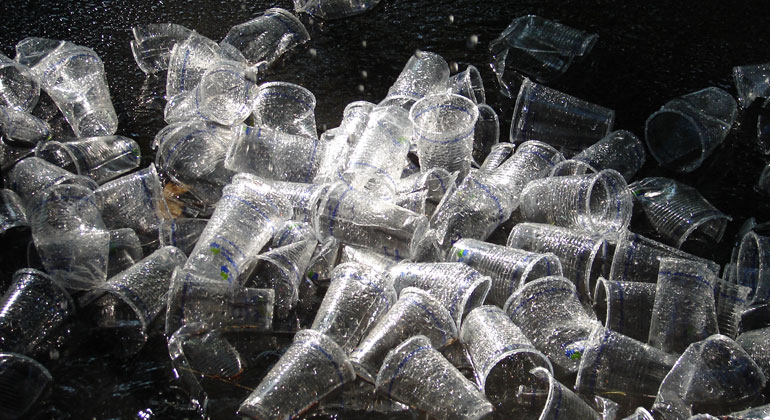Micro- and nanoplastics detectable in human tissues
The researchers involved with the work highlighted in this release analyzed 47 human tissue samples by mass spectrometry, and these samples were found to have monomers, or plastic constituents, in them.
These samples were not spiked with plastics. In separate experiments, the researchers spiked tissue samples with polymers (plastic beads), and found they could use flow cytometry to detect the polymer plastics that they introduced in tissues. In future work, these methods will be used to see if nanoplastics can be detected in human tissues. Edits have been made in the press release to clarify this information.
Plastic pollution of land, water and air is a global problem. Even when plastic bags or water bottles break down to the point at which they are no longer an eyesore, tiny fragments can still contaminate the environment. Animals and humans can ingest the particles, with uncertain health consequences. Now, scientists report that they are among the first to examine micro- and nanoplastics in human organs and tissues.
The researchers will present their results today at the American Chemical Society (ACS) Fall 2020 Virtual Meeting & Expo. ACS is holding the meeting through Thursday. It features more than 6,000 presentations on a wide range of science topics.
“You can find plastics contaminating the environment at virtually every location on the globe, and in a few short decades, we’ve gone from seeing plastic as a wonderful benefit to considering it a threat,” says Charles Rolsky, Ph.D., who is presenting the work at the meeting. “There’s evidence that plastic is making its way into our bodies, but very few studies have looked for it there. And at this point, we don’t know whether this plastic is just a nuisance or whether it represents a human health hazard.”
Scientists define microplastics as plastic fragments less than 5 mm, or about 0.2 inches, in diameter. Nanoplastics are even smaller, with diameters less than 0.050 mm. Research in wildlife and animal models has linked micro- and nanoplastic exposure to infertility, inflammation and cancer, but health outcomes in people are currently unknown. Previous studies have shown that plastics can pass through the human gastrointestinal tract, but Rolsky and Varun Kelkar, who is also presenting the research at the meeting, are studying if the tiny particles accumulate in human organs and how to detect them. Rolsky is a postdoctoral scholar and Kelkar is a graduate student in the lab of Rolf Halden, Ph.D., at Arizona State University.
To find out, the researchers collaborated with Diego Mastroeni, Ph.D., to obtain samples from a large repository of brain and body tissues that was established to study neurodegenerative diseases, such as Alzheimer’s. Samples were taken from lungs, liver, adipose tissue, spleen and kidneys –– organs likely to be exposed to, filter or collect plastic monomers and microplastics. To develop a method and test it, the team spiked nano/microplastic beads into this sample set. Then, they analyzed the sample with flow cytometry. With this procedure, the researchers showed that they could detect the beads that they introduced into these samples. The researchers also created a computer program that converted information on plastic particle count into units of mass and surface area. They plan to share the tool online so that other researchers can report their results in a standardized manner. “This shared resource will help build a plastic exposure database so that we can compare exposures in organs and groups of people over time and geographic space,” Halden says. The flow cytometry method allowed the researchers to show that they can detect nano/microplastics from tissues to which these had been added. The researchers also demonstrated the use of μ-Raman spectrometry to study environmental contamination with microplastics, including polycarbonate (PC), polyethylene terephthalate (PET) and polyethylene (PE).
Next, the researchers used another method called mass spectrometry to analyze 47 human liver and fat tissue samples. No materials were spiked into these samples. The team found plastic contamination in the form of monomers, or plastic building blocks, in every sample. Bisphenol A (BPA), still used in many food containers despite health concerns, was found in all 47 human samples.
Taken together, to the researchers’ knowledge, their study is the first to examine monomer, nano- and microplastic occurrence in human organs from individuals with a known history of environmental exposure. “The tissue donors provided detailed information on their lifestyle, diet and occupational exposures,” Halden says. “Because these donors have such well-defined histories, our study provides the first clues on potential micro- and nanoplastic exposure sources and routes.”
Should people be concerned about the high detection frequency of plastic components in human tissues? “We never want to be alarmist, but it is concerning that these non-biodegradable materials that are present everywhere can enter and accumulate in human tissues, and we don’t know the possible health effects,” Kelkar says. “Once we get a better idea of what’s in the tissues, we can conduct epidemiological studies to assess human health outcomes. That way, we can start to understand the potential health risks, if any.”








